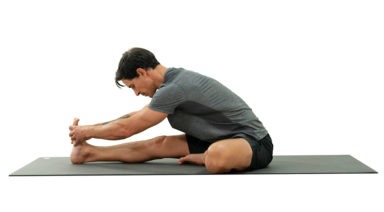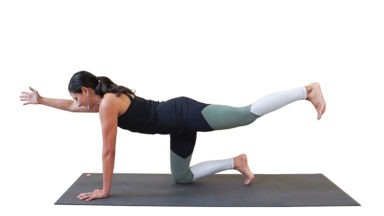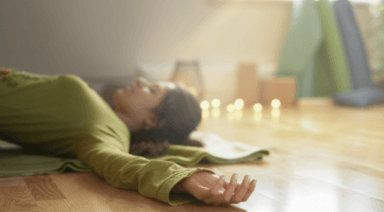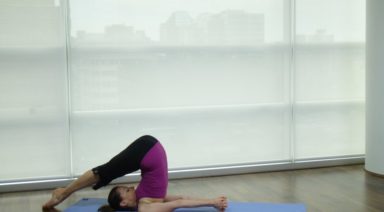Yoga Breathwork for Quick Sinus Relief

4 Minute Pranayama Kapalbhati Breathing Tutorial
Though it may seem counter-intuitive, breathing is another practice that can alleviate sinus discomfort. Try the following practices with a calm and relaxed demeanor, focusing on keeping your prana moving smoothly. You may wish to blow your nose, or better yet, use your neti pot before you try these exercises.
Belly Breathing
Lie on your back with your knees bent and your hands on your belly. Breathe deeply into the belly, focusing on expanding the belly like a buddha, then draw the breath and energy up through your ribs, chest and shoulders. Exhale the same way, deflating your belly, chest and shoulders, and squeezing all the air out of your belly. Find your own rhythm.
Calming Breath
Sit comfortably. Bring your right hand out in front of you, palm facing you. Fold your index and middle fingers into the palm. Place your ring finger on your left nostril to close it off. Breathe into the right nostril for two counts. Close off the right nostril with the thumb and hold the breath for two counts. Release the left nostril, exhale for two counts. Close off the left nostril and hold the breath for two counts. Try visualizing a square. If it feels uncomfortable to hold the breath, simply pause instead. Increase the count as you become comfortable, making sure that you are doing equal counts for each action.
Breath of Fire
In this practice, hold your hand over your navel, and practice forcefully exhaling out the nose repeatedly. Your belly should be pumping in and out. The force of the exhale will naturally draw in a new breath, so there is no need to inhale consciously. You may start this practice by gently panting, but it is important to eventually speed up the pace of this breath in order to stoke the “fire” of the breath.
TRY THESE PRACTICES
Feel Healthier and Younger! 5 Detoxifying Habits to Begin

- Dry Brush Your Beautiful Skin
Europeans have used [skin brushing](/video/ayurveda-action-plan-skin-brushing} as an effective method of detoxification for centuries. It’s a simple detox technique which removes toxins accumulated in dead skin cells while simultaneously enhancing circulation. If you brush your skin every day for three minutes, you will be giving it a cleanse that is better than a traditional soap cleaning or bath. In fact, there’s simply no soap that can wash the skin as clean as the new skin which lies beneath the old.
Dry skin brushing your whole body every morning before you shower will do your skin so much good – even if you can’t see it. Just trust in the process because it works! Make sure you use an all-natural dry skin brush, and brush from the feet and hands in the direction of the center of your body. Be sure to brush the bottoms of the feet because nerve endings in your feet affect the whole body. Use lighter strokes over breasts and avoid your nipples if you can. Wash your brush every few weeks in water and let it dry. Get blissed out in the sensation of newly invigorated skin!
- Sweat It Out!
Perspiration is so very, very good for you. It’s an absolutely essential ingredient for healthy skin. Sweating detoxifies and cleanses the skin. If you only sweat for twenty minutes every day, you’ll be doing your skin a world of good. The body detoxifies through the skin, the body’s largest organ of elimination, by sweating. In many traditional cultures around the world, sweating is the first thing people do when they feel a cold or flu coming on. How many times a week do you sweat? For some of us, depending upon our constitution, it’s much easier to sweat than others. But for all of us – no matter what dosha dominates – there are ways to sweat every single day.
For starters, there’s cardiovascular exercise and vinyasa or Bikram yoga classes. Then there are steam rooms and infrared saunas. You can also have some fun in the bedroom by revving up your sexual activity with your partner to get the body sweating and releasing toxins. Whatever you choose to do, try to sweat regularly to maintain optimal health and remove those unwanted toxins.
- Drink Chaga Tea
Chaga, the king of super foods, is a natural detoxifying agent. You can take it in a number of forms, such as powders, capsules, or tinctures. But sipping it in tea form is a great way to relax and drink it as a daily tonic, the way it’s been done for thousands of years by traditional cultures around the world. Chaga is naturally detoxifying because it is a super food that directly impacts the immune system – in a good, good way.
When we feed our bodies with this immune super food, it detoxifies itself naturally because fifty percent of the detox process is simply the immune system working to eliminate toxins. Chaga is also one of the highest antioxidant foods in the world, second only to cacao. Antioxidants detoxify the body, too, by preventing our liver from being overtaxed with oxidative stress.
- Go To Bed and Wake Up at the Same Time Every Day
Research has shown us over and over again that serious sleep deprivation has the same negative effects on the body as do illness and stress. Our body naturally goes to work for us when we sleep, and getting enough sleep is crucial to the body’s natural mechanisms of detoxification. For the brain in particular to detoxify, adequate sleep is absolutely essential.
There’s something referred to as the glymphatic system, which is simply defined as the brain’s system of removing toxins that can lead to such diseases such as Alzheimer’s and other brain maladies. It’s like the lymphatic system for your brain. When we get a good eight hours of sleep on average, the brain “takes out the trash.” Sleep is absolutely essential for removing toxic waste products.
- Twist It Out With Yoga
Yoga postures that twist and turn the body have a natural detoxifying effect. They get things movin’ and groovin’ inside, enhancing the digestive system, while giving the organs a nice, internal massage. When we get into twisting poses, our organs are compressed. This action actually moves blood that inevitably gets filled with toxins out of our system. Twists also flood the liver and kidneys with oxygen while getting blood flowing to those organs of elimination. Try to detox daily by sitting in seated spinal twist and breathing for six to ten breaths.
Other excellent yoga poses for detoxification include: chair twists, wide-legged forward fold with twist, cat/cow (not a twisting pose but still great for digestion), supine twists, twisted side angle pose, downward dog with a twist, crescent lunge twist, and marichiyasana.
In addition, all inversions are also excellent for detoxifying as they soothe the nervous system while stimulating circulation and lymph in the legs and feet, bringing oxygenated blood to the abdomen and brain. While you do your yoga postures, try breathing through the nose. This, too, has a detoxifying effect because many environmental pollutants get stopped in the mucous membranes of the nasal passages when we breathe through the nose. They then travel to the digestive system where they are broken down and eliminated from the body.
Good luck with your whole body demo habits! Your body will love you for bringing these new habits into your life.




































